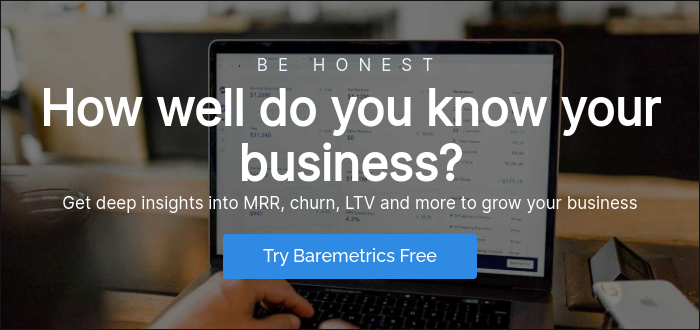Table of Contents
More Business Academy Articles
Is starting a SaaS company a sure-thing or a pipe dream?
Depends on who you ask.
An ever-growing $150 billion market that shows no signs of slowing down, to say that the SaaS business model is proven would be the ultimate understatement.
That said, making that model work is much, much easier said than done.
It’s no secret that most software startups struggle to get off the ground (let alone thrive). This is all despite what you might hear via LinkedIn or the latest SaaS “guru” (ugh).
Listen: understanding the fundamentals of the SaaS business model should be the bare minimum for any founder or business owner interested in throwing their hat in the ring.
In this guide, we’ll break down the basics for anyone totally new to SaaS.
Table of contents
- What makes the SaaS business model unique?
- What are the benefits of a SaaS business model?
- What are the downsides of the SaaS business model?
- The stages of a SaaS company
- What’s the exit plan for SaaS businesses?
What makes the SaaS business model unique?
Perhaps the most significant aspect of running a SaaS business is in the name.
That is, software as a service.
You aren’t just selling a product. You’re a full-blown service provider.
And so your customers aren’t a one-and-done affair. Once someone becomes a user, they’re your customer for the foreseeable future (and ideally forever).
This directly impacts everything from how you market your product, communicate with customers and approach sales. Below are three details that set the SaaS business model apart from a more “traditional” business.
You’re laser-focused on customer retention (versus acquisition)
For starters, customer retention is at the core of SaaS.
Remember: your goal is to keep customers around for the long haul. This means that your product needs to go beyond meeting an initial pain point or customer need. Instead, it needs to become integral to your customers’ life.
Sounds a bit dramatic, right? But think about SaaS tools like Gmail, Trello or Slack which many companies couldn’t imagine themselves living without.
The fact that there are alternatives to all of the above popping up left and right signals the importance of keeping customers satisfied so they don’t jump ship.
This means regularly touching base with customers, gathering feedback and answering questions to ensure that everyone’s on the up-and-up. SaaS companies are often the gold standard when it comes to customer satisfaction, offering self-help channels and speedy social support so users are never left waiting.
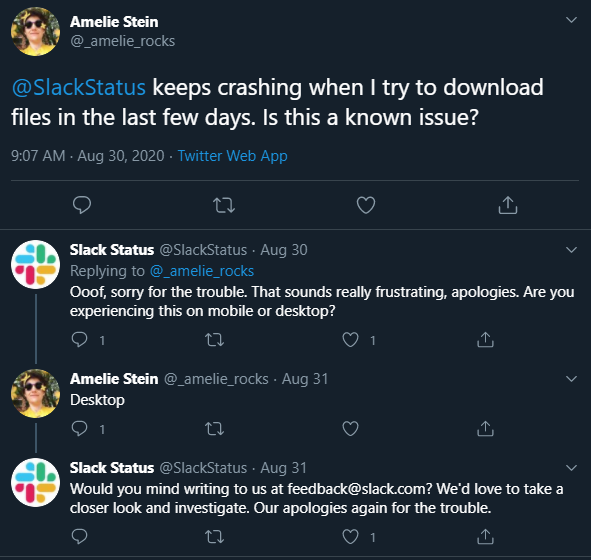
It’s well-documented that it costs way more to acquire new customers than it does to retain the ones you have. The SaaS business model is centered around this concept.
You’re always acquiring new customers
This might seem contradictory to the point above, but let’s break it down.
Let’s say you run a SaaS company and you just hit the milestone of 10,000 users.
Congrats!
Now, at this point are you going to consider your business “finished?” Or are you going to start brainstorming ways to score your next 10,000 users?
Exactly.
Long-term survival in SaaS means constantly bringing new users into your funnel. Whether it’s through paid advertising, SEO or social media (often all three), your business’ survival depends on a constant influx of new users.
This is especially true given that most SaaS companies operate on a free or freemium model, meaning that not every user is actually a paying one. Although some of those free users will eventually convert, many of them won’t. That’s reality.
Meanwhile, you also have to consider how many customers churn (stop using your service) on a month-to-month basis. Whether it’s due to their budgets or a competing product on the market, churn is inevitable.
All of this speaks to how much the SaaS business model relies on numbers and data to ensure customers are coming through at a healthy rate, leading us directly to our next point.
Your decision-making is dependent on data
Companies of all shapes and sizes should have a pulse on their metrics and KPIs.
Well, SaaS is no different. The key distinction is that, by nature, SaaS companies can keep a closer eye on their customers’ behavior (think: how much they’re spending, how often they use a product) versus a one-off transaction.
There are plenty of SaaS metrics that companies need to monitor, all of which can indicate whether or not your business is on the right track This includes:
- ARPU (average revenue per user, how much revenue you’re generating for each active customer)
- MRR (monthly recurring revenue, how much revenue your business is generating month-to-month)
- Churn (again, the rate at which people stop using your service)
- Conversion rate (the percentage of people who become paying customers from trials or free products)
Using tools like Baremetrics, you can track and analyze all these metrics (and more) to identify trends, where you’re winning and areas of concern.
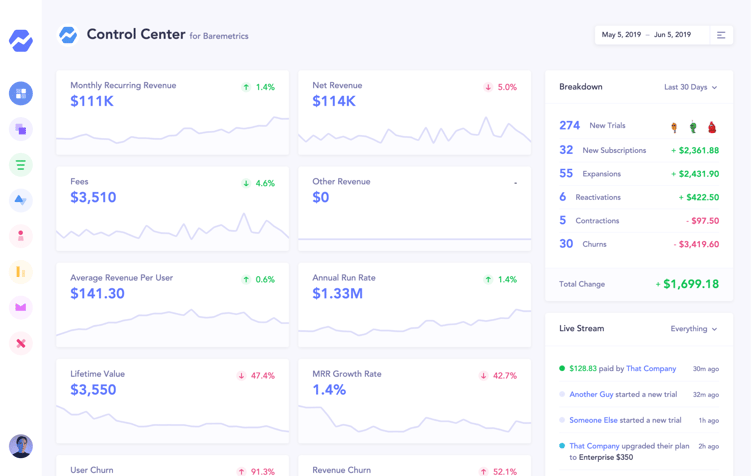
be honest
How well do you know your business?
Get deep insights into MRR, churn, LTV and more to grow your business
What are the benefits of a SaaS business model?
There’s no denying that SaaS is inherently stressful, especially for up-and-coming companies.
That said, there are some inherent benefits to the SaaS business model which we’ve broken down below.
Scaling can happen super fast
This is the big one and arguably why so many people are attracted to SaaS in the first place.
You don’t have to look hard to uncover success stories of SaaS companies that happened seemingly overnight.
For example, how Zoom quadrupled their revenue in the span of a year. Or how Intercom managed to scale from $1M to $500M.
All of this isn’t to put stars in your eyes, but rather highlight the potential that SaaS companies have to scale. An up-and-coming software company can become “the next big thing” in a matter of weeks.
Is this the norm? Not necessarily. Does it happen? Absolutely.
Another reason that SaaS companies can grow quickly is due to remote hiring. The fact that SaaS teams are inherently tech-savvy and remote-friendly means not only that they can hire talent from anywhere and everywhere, but they also aren’t tied down by the expenses of a traditional office.
Look no further than sites like Angel.co to see just how much remote hiring has exploded in SaaS.

You can reach big-spenders and budget customers at the same time
Most SaaS companies don’t sell a single product, but instead offer a variety of product tiers.
Free. Standard. Premium. You get the picture.
The concept is simple: free products have limited features while premium services include full features (and often added bonuses such as extended customer service). Below is an example from MailChimp.
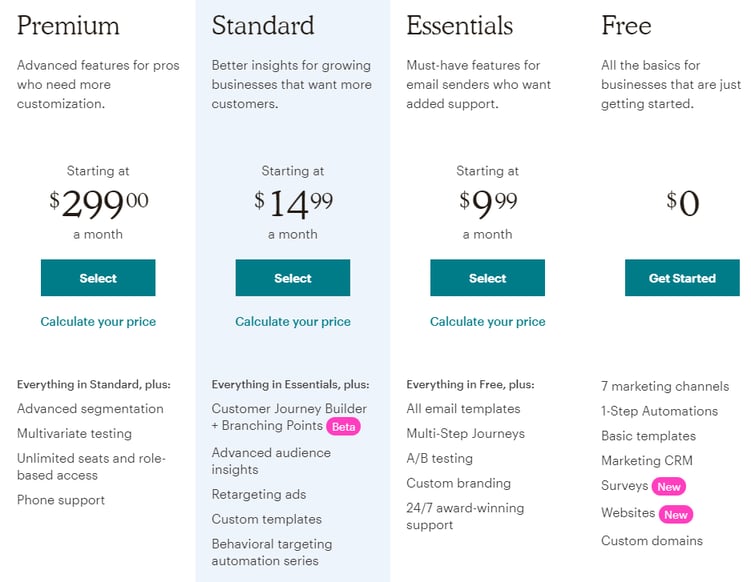
With paid services ranging from free to $300/mo, email software like MailChimp manage to appeal to businesses both big and small.
The benefit of this approach to pricing is two-fold. For starters, you’re able to more accurately experiment with your pricing structure to understand what customers are willing (or aren’t willing) to pay.
At the same time, you also appeal to customers who are looking for a boutique or budget solution without getting pigeonholed as one or the other. It’s a win-win. Check out this article to learn more about how to price your SaaS product.
Predictable revenue leads to less stress, sounder decision-making
Barring an economic catastrophe or PR disaster, SaaS companies have relatively steady revenue month-to-month. And they’re not as doomed by seasonality as some other business models (for the most part).
This is because customers commit simply by being subscribers, meaning you don’t have to hope and pray that they buy from you again.
This consistency offers at least some peace of mind and makes it easier to understand how much money you should expect to be available for marketing, hiring and scaling in general.
Some months might be slower than others, but you can create a general forecast of how your business is doing (and will do) based on your past performance. Here’s an example from Baremetrics’ own forecasting calculator.

What are the downsides of a SaaS business model?
We’ll bite: SaaS isn’t all sunshine and rainbows. Below are some rather harsh realities of running a SaaS business.
The software space is comically crowded with competition
No surprises here. Regardless of your niche, competition is cutthroat in software.
TechCrunch’s annual startup in memoriam also serves as a reminder of how many would-be success stories end up going under. Don’t forget about the notorious Martech 5000 (which actually consists of 8,000+ companies), illustrating just how crowded the marketing software space alone is.
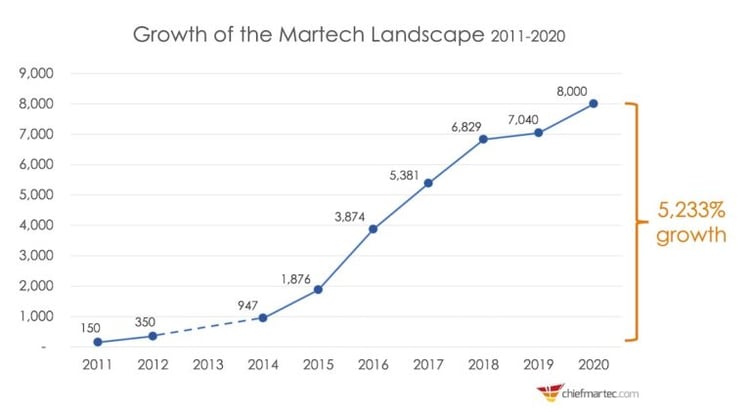
Getting your initial customer(s) can be slow and frustrating
While this fact rings true for any type of business, it’s particularly frustrating for SaaS.
The key challenge here is that you’re often competing with companies that offer a similar service to your own for free. Convincing people to pay up for something they could get for cheaper (or from someone with name recognition ala Google) is a tough sell.
And so clawing tooth and nail for your first user, let alone customer, is an absolute grind. Determining what you’re doing right (or wrong) is also ambiguous when you don’t have any customer data to go off of.
There’s also the inherent pressure to prove your product’s viability ASAP. The longer you have to wait for that first customer, the more doubt hangs over you.
Your business represents a long-term customer commitment
Again, you’re selling a service.
Don’t let anyone try to sell you on the idea that the SaaS business model somehow represents “passive income” (whatever that means).
If you want customers to stick around, you’re going to need to regularly reach out and market to them. Failing to do so makes it so much easier for them to bounce to a competitor.
Speaking of which, new competitors and tools will likewise force you to roll out new features and updates unless you want to get left in the dust.
What are the stages of a SaaS company?
Rarely do SaaS companies follow a set “path” in terms of how the scale and their timeline of growth. That said, there are four stages that are part of the SaaS business model.
Below is a quick breakdown of the various stages of SaaS companies.
Pre-startup
This might be the same stage you’re in right now! In short, you’re assessing the viability of your product, talking to advisors and exploring opportunities in your industry.
Perhaps you’re assessing your market need and figuring out whether or not your solution has a fit. This is ultimately where you’ll craft your business plan.
Startup
At this point, you’ve launched and you’re on the hunt for paying customers. Resources will be tight (assuming you’re bootstrapped or even have a little bit of funding), but this is the point where you’ll begin making hires and essentially putting yourself out there.
Your product and positioning may continue to evolve as you learn more about your market and customer needs first-hand.
Growth
The growth stage represents the stage where customers are rolling in and your business is showing signs of becoming sustainable.
Here you’re still married to metrics, all the while acquiring more customers and testing new strategies. By this point, you’ll have ironed out your sales process and can scale it.
Maturity
This is where you’ll begin exploring your exit strategy, which typically means an IPO or acquisition by another company.
You’re continuing growth, but you can ultimately prove the effectiveness of your product and processes without fail. Here you might also consider new products, features or services to test.
What’s the end-game for a successful SaaS company?
Last but not least, an exit strategy is key to the traditional SaaS business model.
The end-game of most companies is simple: go public or get bought out.
Talking about the upsides (and realities) of one versus the other would be a whole other post. Simply put, many SaaS companies get acquired by existing software giants. Here’s some evidence via recently acquired companies on Crunchbase:

Going public is obviously a much more ambitious (and seemingly risky goal), but it definitely happens. Below is a snapshot of some major SaaS IPOs for reference.

But note that this “either-or” exit approach is changing. For example, right now there are companies like ConvertKit and Ahrefs which boast multi-million dollar MRRs that are looking to stay the course. In fact, ConvertKit’s Nathan Barry explicitly states that the company has no exit strategy.
The takeaway here is that SaaS isn’t all-or-nothing when it comes to your end-game Although some companies are laser-focused on getting acquired, others have no problem staying independent.
Does the SaaS business model make sense for you?
Phew! Okay, there’s obviously a lot to consider when it comes to SaaS and the fine details of what it means to get a company up-and-running.
Either way, we hope this breakdown helped give you a clear expectation of what starting a SaaS business actually entails. Just remember that tools built into Baremetrics are perfect for tracking your company’s numbers every step of the way.
Written by: Brent Barnhart
